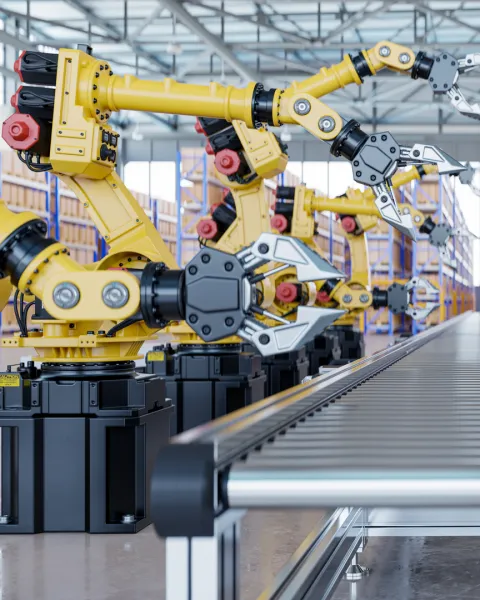The phrase “artificial intelligence” or “AI” often instills unease and nervousness. In manufacturing, the use of computerized knowledge or AI to convert once-manual tasks into highly automated mechanized tasks evokes equal parts excitement and concern. Reports of wrecks caused by self-driving cars and tales of robotic tools going haywire raise the question of how the manufacturing industry can balance the use of AI and its commitment to safety for employees, customers, and others.
When it comes to employee safety, the primary law is the Occupational Safety and Health Act of 1970, otherwise known as the OSH Act. The Occupational Safety and Health Administration (OSHA), a U.S. Department of Labor agency, has primary policy-making and enforcement responsibility for the OSH Act and its implementing regulations over private sector employers. Of course, the manufacturing industry is no stranger to OSHA. Safety concerns have been on manufacturers’ minds for decades. But the use of AI triggers other, lesser-known OSHA concerns that employers may want to investigate.
Uses for AI in Promoting Safety
AI can be used in a plethora of ways to not only make certain processes more efficient, but to determine when certain additional safety measures are needed. For instance, AI can be useful in determining when vehicular equipment operators within a facility need a break, in assessing exposure limits to hazardous conditions or chemicals, and in reducing mechanical failure or accidents with automation. Likewise, cameras can detect whether workers are using the correct personal protective equipment (PPE) and whether certain PPE is adequate and up to date. This can reduce human errors and may allow employees to attend to other, non-automated tasks.
Uses for AI to Monitor, Engage with Employees
The use of AI can be helpful on the human side, too. AI can help with people management tasks, including shift or task assignment, management of communication between workers and management, or even measuring cognitive impairment to ensure the safe and proper use of equipment as with fatigue monitoring and other assessments. These assessments can be nearly impossible for HR or managers to measure and can eliminate implicit biases that may be present when people perform these tasks. Of course, all laws, not only the OSH Act, but statutes as diverse as the Americans With Disabilities Act and the National Labor Regulations Act, may also be implicated.
Worries of Accidents
Even in human and robot (or “co-bot”) situations, where employees are working alongside robots, the fear of malfunction exists. If a co-bot working alongside an employee collides with the employee on duty, for instance, the employer then needs to worry about possible OSHA violations, workers’ compensation claims, and other AI-focused factors of liability. OSHA’s lockout tagout (LOTO) regulations are also a major concern with robots. This AI hybrid may lead the employee or public to question whether the employer cares more about efficiency or safety.
Manufacturing employers must also beware of privacy risks. AI can collect and store large amounts of employee data. If these systems are breached, employers may be liable under data privacy laws. The additional data that AI collects also may make employees uneasy or feel as if the employer is acting as “Big Brother” in using technology, all in the name of efficiency.
Looking Ahead
Employers in the manufacturing industry using or contemplating the use of AI need to ensure the technology is complying with safety and privacy laws. They may also need to enact data protection and other policies when using AI. The use of AI does not mean safety audits should occur less frequently either. Continued safety audits are a must, even for automated AI-controlled technology. At a minimum, there should be a safety barrier between humans and AI-related technology, including the use of robot or co-bot machinery. This will assist in the event of a one-off accident and may be used to show OSHA that the accident was a rare occurrence.
With the growing popularity of AI, it is inevitable that OSHA will need to consider this technology when it updates its LOTO standard. However, rulemaking to revise the existing LOTO standard has disappeared from OSHA’s regulatory agenda in 2023, after the agency failed to hit its target date of September 2022 for a proposed rule. The LOTO standard has not been substantively updated since 1990, other than a one-word update in 2011. In the meantime, employers need to balance the use of AI, employee safety, and regulatory compliance, particularly given OSHA’s sorely outdated LOTO standard that has not caught up with the technology over the last 30+ years.
Please contact a Jackson Lewis attorney with any questions.
© Jackson Lewis P.C. This material is provided for informational purposes only. It is not intended to constitute legal advice nor does it create a client-lawyer relationship between Jackson Lewis and any recipient. Recipients should consult with counsel before taking any actions based on the information contained within this material. This material may be considered attorney advertising in some jurisdictions. Prior results do not guarantee a similar outcome.
Focused on employment and labor law since 1958, Jackson Lewis P.C.’s 1,100+ attorneys located in major cities nationwide consistently identify and respond to new ways workplace law intersects business. We help employers develop proactive strategies, strong policies and business-oriented solutions to cultivate high-functioning workforces that are engaged and stable, and share our clients’ goals to emphasize belonging and respect for the contributions of every employee. For more information, visit https://www.jacksonlewis.com.



